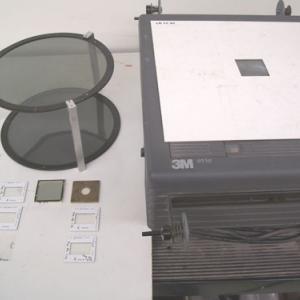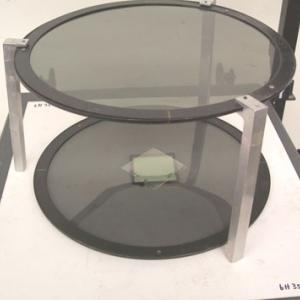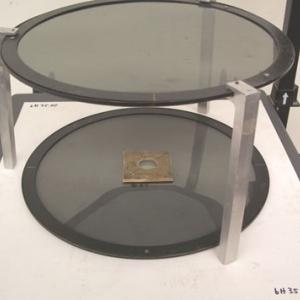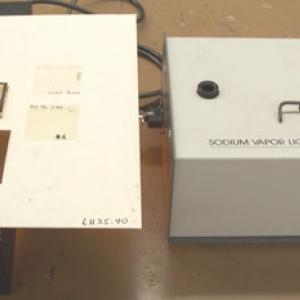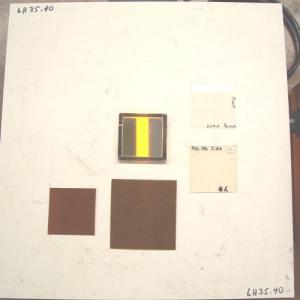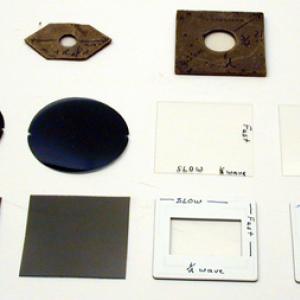College of Liberal Arts & Sciences
6H35.40 - Quarter and Half Wave Plates
Place the mask on the overhead and then place the # 57 interference filter in the square hole. This will give you a very narrow band of wavelengths centered around 560 nm. (see the spectrograph done with the Ocean Optics spectrometer that is with the filter). Place one Polaroid directly on top of the filter and then place the other Polaroid as shown and turn it until you achieve extinction. Place the 1/4 wave plate at 45 degrees to the filter and observe that no matter how you turn the top Polaroid now you can not get extinction. In fact the intensity of light you see should be almost the same throughout the rotation. The 1/4 wave plate has circularly polarized the light coming through the bottom Polaroid.
Using the same filter and Polaroid setup as above rotate the top Polaroid to achieve extinction. Place the 1/2 wave plate at 45 degrees to the filter and now note that you have to turn the top Polaroid 90 degrees to achieve extinction (basically you can put the 1/2 wave plate in at any angle to the filter and observe that you will have to rotate the top Polaroid twice that angle to achieve extinction).
You can also use the Pasco sodium light as your light source instead of the overhead projector. It will also help if you use the # 57 filter in this instance.
There is also some homemade 1/4 plates made out of tape.
NOTE: These work at a 650 nm wavelength and because of this, they are not as visible as the plate described above.
- Stefan Richtberg and Raimund Girwidz, "Use of Linear and Circular Polarization: The Secret LCD Screen and 3D Cinema", TPT, Vol. 55, #7, Oct. 2017, p. 406.
- Eugene Torigoe, "Representing Circular Polarization with a Box of Cereal", TPT, Vol. 50, #3, Mar. 2012, p. 188.
- Kelly Kriebel and Joseph L. Powlette, "A Simple Apparatus for Optical Polarization Experiments", TPT, Vol. 41, #9, Dec. 2003, p. 537.
- Paul Chagnon, "Animated Displays IV: Linear Polarization", TPT, Vol. 31, #8, Nov. 1993, p. 489, and referenced in Resource Letter TLC-1 Teaching Light and Color, Demonstration Experiments Resource Articles.
- Tom A. Kuusela, "Methods to Depolarize Narrow and Broad Spectrum Light", AJP, Vol. 89, #10, Oct. 2021, p. 963.
- Paul R. Camp, "Inexpensive Optics for Polarized Light Demonstrations", AJP, Vol. 65, #5, May 1997, p. 449.
- P. C. B. Fernando and S. Samarasinghe, "A Technique for Experimentally Observing the Polarization Ellipse", AJP, Vol. 64, #5, May 1996, p. 565.
- Walter Roy Mellen, "Interference Patterns from Circularly Polarized Light Using a Michaelson Interferometer", AJP, Vol. 58, #6, June 1990, p. 580.
- H. M. Lai, Lai‐Yung Leung, Kwok‐Leung Lee and K. P. Chik, "Mechanical Analog of Optical Retarders", AJP, Vol. 54, #5, May 1986, p. 455.
- W. Herreman, H. Hotebaert, "Circularly Polarized Waves: A Mechanical Demonstration", AJP, Vol. 51, #1, Jan. 1983, p. 91.
- Johanna L. Miller, "Circular Polarization is Made to Order in the Extreme UV", Physics Today, Vol. 72, #4, Apr. 2019, p. 17.
- Jermey N. A. Matthews, "A Mantis Shrimp's Extraordinary Eyes", Physics Today, Vol. 62, #12, Dec. 2009, p. 21.
- Jearl Walker, "The Amateur Scientist: What Causes the Color in Plastic Objects Stressed Between Two Polarizing Filters?", Scientific American, Vol. 248, #6, June 1983, p. 146.
- Jearl Walker, "The Amateur Scientist: Studying Polarized Light with Quarter-Wave and Half-Wave Plates of One's Own Making", Scientific American, Vol. 238, #1, Jan. 1978, p. 132.
- G. D. Freier and F. J. Anderson, "Om-10, 11", A Demonstration Handbook for Physics.
- Wallace A. Hilton, "P-1", Experiments in Optical Physics, p. 57.
- T. Kallard, "The Quarter-wave Retardation Plate and Circularly Polarized Light", Exploring Laser Light, p. 91.
- T. Kallard, "The Effects of a Half-wave Retardation Plate on Polarized Light", Exploring Laser Light, p. 90.
- Frank S. Crawford, Jr., "Waves", Berkeley Physics Course - Vol. 3, p. 422 - 535.
- Gordon McComb, "Retardation Plates", Lasers, Ray Guns, & Light Cannons, p. 130 - 131.
- C. Harvey Palmer, "Experiment C3: Simple Polarization Demonstrations", Optics - Experiments and Demonstrations, John Hopkins Press, 1962.
- "10. Circularly and Elliptically Polarized Light", Experiments in Optics, Part 2, Klinger Scientific Apparatus Corp., Bulletin 101-2.
- T. D. Rossing and C. J. Chiaverina, "7.6, Wave Plates", Light Science, Physics and Visual Arts, p. 162.
- W. Bolton, "18. Rotation of the Plane of Polarization of Microwaves", Book 2 - Waves and Particles, Physics Experiments and Projects, 1968, p. 28.
- "Circular Polarization", Harvard University Natural Sciences Lecture Demonstrations.
Disclaimer: These demonstrations are provided only for illustrative use by persons affiliated with The University of Iowa and only under the direction of a trained instructor or physicist. The University of Iowa is not responsible for demonstrations performed by those using their own equipment or who choose to use this reference material for their own purpose. The demonstrations included here are within the public domain and can be found in materials contained in libraries, bookstores, and through electronic sources. Performing all or any portion of any of these demonstrations, with or without revisions not depicted here entails inherent risks. These risks include, without limitation, bodily injury (and possibly death), including risks to health that may be temporary or permanent and that may exacerbate a pre-existing medical condition; and property loss or damage. Anyone performing any part of these demonstrations, even with revisions, knowingly and voluntarily assumes all risks associated with them.
